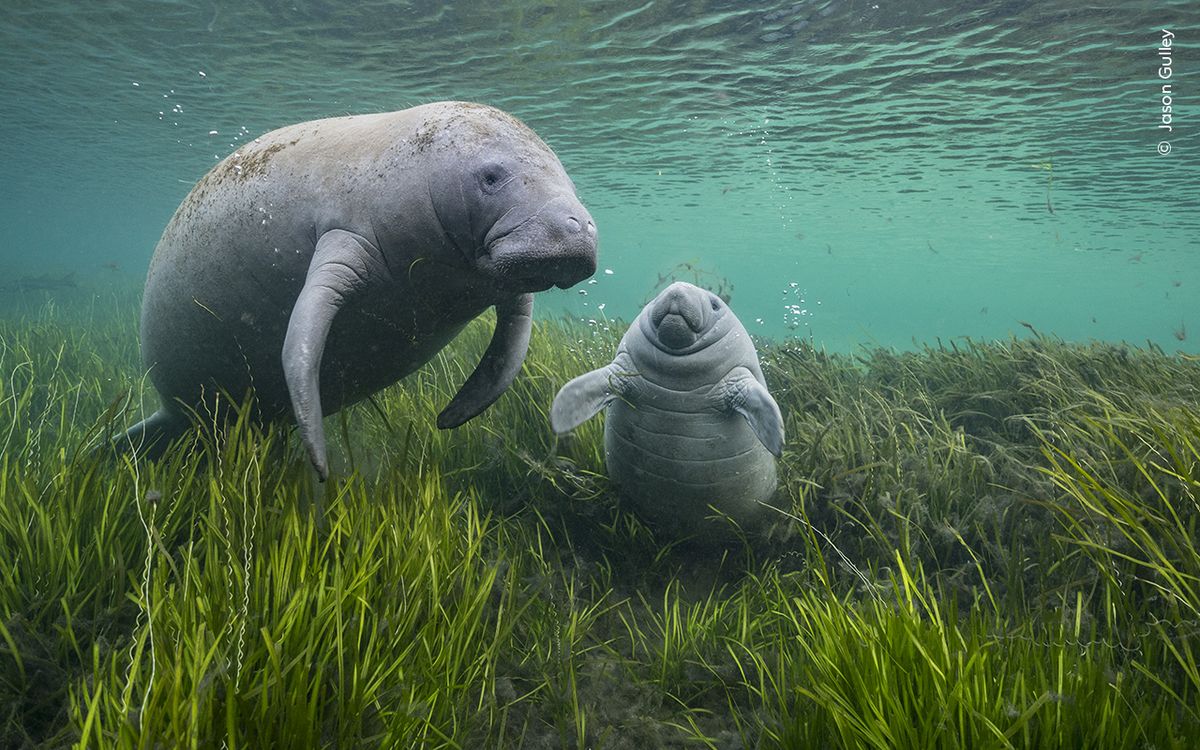For those who turn their lenses toward nature, the Wildlife Photographer of the Year contest is among the most prestigious awards—it’s been referred to as the “Oscars of wildlife photography.”
Now in its 60th year, the competition drew in nearly 60,000 submissions from 117 countries and territories around the globe for its 2024 contest. While the winners have yet to be announced, the Natural History Museum in London, which develops and produces the competition, recently released a collection of highly commended images that offer a sneak peak of what’s to come.
From a leaping stoat to a baby manatee and a frost-covered deer, the images honored in this year’s contest reveal both tender and tense moments in nature.
“In this selection you see species diversity, a range of behavior and conservation issues,” says Kathy Moran, chair of the judging panel, in a statement. “These images represent the evolution of the competition through the years, from pure natural history to photography that fully embraces representation of the natural world—the beauty and the challenges. It is a powerful selection with which to kickstart a milestone anniversary.”
One hundred photographs from this year’s competition will go on display at the museum beginning October 11. To recognize six decades of the photography contest, the exhibition will also include a timeline of key moments in its history.
Below, take a look at 13 highly commended images that set the stage for the upcoming exhibition and offer a glimpse into wondrous animal behaviors and the often strained relationship between humans and nature.
Going with the Floe by Tamara Stubbs
Two snoozing crabeater seals poke their heads above the water in the Weddell Sea. Tamara Stubbs and Atlantic Productions / Wildlife Photographer of the Year/https://tf-cmsv2-smithsonianmag-media.s3.amazonaws.com/filer_public/21/b7/21b7a172-6ea8-4ec2-a480-bc43aa753e06/tamara_stubbs_and_atlantic_productions_wildlife_photographer_of_the_year.jpg)
While on a nine-week expedition in Antarctica’s Weddell Sea, photographer Tamara Stubbs of the United Kingdom spotted these two crabeater seals taking a nap. The pair had fallen asleep near the ship, often submerged enough that only the tips of their noses poked out of the water.
“Every now and then the head would come up for a bigger breath, and two came up together, handing me this photo opportunity,” Stubbs writes on Instagram. “I can’t tell you how magical it was to watch, and hear, as they were all snoring away. Some moments in life are complete treasure, and this was definitely one of those moments.”
Crabeater seals are the most abundant seal species in the Southern Ocean, numbering roughly four million. Despite their name, they do not eat crabs—instead, they’ll dine on krill. But these tiny crustaceans require sea ice, especially during the larval phase of their lives—and climate change is putting them at risk by driving down polar sea ice coverage.
As Clear as Crystal by Jason Gulley
A mother manatee and her calf in Florida’s Crystal River amid eelgrass, which is crucial for supporting the large mammals. Jason Gulley / Wildlife Photographer of the Year/https://tf-cmsv2-smithsonianmag-media.s3.amazonaws.com/filer_public/1a/3d/1a3d1353-7317-4f5f-8b89-23cd066a4535/jason_gulley_wildlife_photographer_of_the_year.jpg)
American photographer Jason Gulley has photographed many a manatee, but this image of a mother and calf in Florida’s Crystal River remains one of his favorites. That’s not only because of the calf’s expression, or the bubbles trickling up from its flippers, but because it represents a success story of manatee conservation.
“Just a few years ago, Crystal River was an underwater wasteland devoid of aquatic vegetation,” Gulley writes on Instagram. Nutrient pollution and human development had set off algae blooms that choked out any other plants in the water—including the eelgrass that manatees rely on. “Today, thanks to the work of biologists, community and non-profit organizations and state agencies, Crystal River is bursting with aquatic grasses that are clearing up the visibility, bringing back fish and sustaining a year-round manatee presence.”
Stormy Scene by William Fortescue
A pair of lions mates in front of storm clouds in Tanzania’s Serengeti National Park. William Fortescue / Wildlife Photographer of the Year/https://tf-cmsv2-smithsonianmag-media.s3.amazonaws.com/filer_public/ac/67/ac6764bf-c713-475c-87c7-2aa4a2a6326e/william_fortescue_wildlife_photographer_of_the_year.jpg)
At Serengeti National Park in Tanzania, these two lions mated several times against an ominous backdrop of storm clouds and the setting sun. William Fortescue of the U.K. snapped images of the interaction, but he didn’t notice the flying saliva or insects shaken from the male’s mane until he saw an enlarged version of this photograph.
“Mating between lions is often visceral and reactions unpredictable. They’ll mate every 15 minutes for three days (with decreasing regularity, if that makes you feel better),” the photographer writes on Instagram. “My guide [Anderson Kayle] and I sat and watched this for three days, failing many times until we got the image I was hoping for.”
Moonlight Hunter by Xingchao Zhu
A Pallas’ cat stares into the camera in Inner Mongolia, China, as the moon sets behind it. Xingchao Zhu / Wildlife Photographer of the Year/https://tf-cmsv2-smithsonianmag-media.s3.amazonaws.com/filer_public/e2/6d/e26d5972-57b8-4ec7-add3-ccd9785e9189/xingchao_zhu_wildlife_photographer_of_the_year.jpg)
Just before dawn, with the moon setting in the background, a Pallas’ cat stares into the lens of Xingchao Zhu of China. The photographer spent days during the Chinese New Year in 2023 traversing the cold plateau of Inner Mongolia, China, tracking a group of Pallas’ cats. This mammal had just captured a small bird when Zhu snapped the photograph.
Pallas’ cats are equipped to survive at altitudes of 16,400 feet, thanks to their thick fur coats. But these hardy creatures are small—roughly the size of a furry, stocky housecat. They tend to avoid larger predators by hiding, using camouflage and concealing themselves behind obstacles.
Strength in Numbers by Theo Bosboom
Mussels cover the shoreline in Praia da Ursa, Sintra, Portugal, just before the tide comes in. Theo Bosboom / Wildlife Photographer of the Year/https://tf-cmsv2-smithsonianmag-media.s3.amazonaws.com/filer_public/4e/14/4e14acb4-8e14-4eb1-8ff8-c9c31d5723d1/theo_bosboom_wildlife_photographer_of_the_year.jpg)
For most people, mussels might not come to the top of the mind when thinking about beautiful wildlife, and their importance to ecosystems is often under-appreciated. But photographer Theo Bosboom of the Netherlands wanted to highlight these mollusks, which he found on a photography trip to western Portugal.
“It was the second visit to this particular beach, which is quite hard to reach due to a steep rocky trail,” writes the photographer on Instagram. “On the way back, we discovered the large colony of mussels and were able to photograph it just before the high tide came in.”
Mussels, which bind together to keep from getting washed off the shore, are filter-feeders that improve water quality by removing plankton, bacteria and toxins. They create ecosystems for small fish, worms and crustaceans and serve as a food source for various larger animals.
Hooked by Tommy Trenchard
A requiem shark is captured as bycatch by a fishing vessel looking for tuna or swordfish in international waters. Tommy Trenchard / Wildlife Photographer of the Year/https://tf-cmsv2-smithsonianmag-media.s3.amazonaws.com/filer_public/0f/64/0f64d59a-2fcb-447c-901a-0071c60def0d/tommy_trenchard_wildlife_photographer_of_the_year.jpg)
South African photographer Tommy Trenchard boarded the Greenpeace ship Arctic Sunrise with a goal of documenting fishing vessels’ accidental capture of sharks. Here, in international waters of the South Atlantic Ocean, he photographed the bycatch of a requiem shark as it fought against the line.
Every year, about 80 million sharks are taken from the oceans, according to a statement accompanying the image. Despite a tenfold increase in regulations against finning, a recent study found that sharks were killed at higher rates in 2019 compared to 2012. Their numbers have fallen worldwide since 1970, and now, more than one-third of shark and ray species are threatened with extinction from overfishing.
Precious Rocks by Samual Stone
A jackdaw collects mud and rocks for its nest in London’s Bushy Park. Samual Stone / Wildlife Photographer of the Year/https://tf-cmsv2-smithsonianmag-media.s3.amazonaws.com/filer_public/c3/6b/c36b9161-d423-4a4e-a890-283b510c9618/samual_stone_wildlife_photographer_of_the_year.jpg)
A pair of jackdaws picked out a hole in a half-fallen willow tree to construct their nest in London’s Bushy Park. Photographer Samual Stone of the United Kingdom watched as the birds returned to the willow toting hair from local deer and other nesting materials.
“I’d not yet seen anything like this though; clumps of mud and rock,” Stone writes on Instagram. “I like the way the clumps are being held in a size order.”
Jackdaws are known for being social and highly intelligent. The birds typically mate for life, and they build new nests each year, gathering twigs, feathers, wool, moss, mud or dung and—in this case—small stones.
The Last Resting Place by Randy Robbins
A frost-covered deer lies on the ground near Susanville, California. Randy Robbins / Wildlife Photographer of the Year/https://tf-cmsv2-smithsonianmag-media.s3.amazonaws.com/filer_public/a2/8c/a28c4b06-cd20-4b0a-9c47-e258179fab8c/randy_robbins_wildlife_photographer_of_the_year.jpg)
While walking in the woods near his California home on a winter morning, checking his camera traps, Randy Robbins came across this frosted deer. Surprised by the find, Robbins snapped this photo with his smartphone.
“I had a big lens with me, but I needed a wide angle,” he writes on Instagram. “The scene was fleeting since the ice was melting, and I knew I’d miss the moment if I tried to return with a wider lens.”
Robbins’ trail cameras had regularly picked up this doe over several years, as she raised multiple sets of fawns on his property, he tells Forbes’ Cecilia Rodriguez. “I see this image as a reminder of the fragility of life and the grand design of it all.”
Center of Attention by Georgina Steytler
Male Dawson’s burrowing bees form a “mating ball” on top of a female, which is white, after she emerges from underground near Carnarvon, Western Australia. Georgina Steytler / Wildlife Photographer of the Year/https://tf-cmsv2-smithsonianmag-media.s3.amazonaws.com/filer_public/9c/01/9c01bd77-6f47-4623-a94a-7fa50481a01e/georgina_steytler_wildlife_photographer_of_the_year.jpg)
Dawson’s burrowing bees emerge from the ground in the spring for a fast-paced frenzy of mating. The males leave their burrows first, and within a few days, the females follow suit. As soon as the females come out, waiting males compete to mate with them.
“What ensues is a furious ‘mating ball’ around the poor female with as many as a dozen male bees all trying to get hold of her and tear away opponents,” Australian photographer Georgina Steytler writes in an Instagram post.
She captured this image of a mating ball using a long lens, lying on the rocky ground amid the heat and wind-blown sand. “These bees have been my passion for the last few years, and I feel privileged to see each new generation that emerges,” Steytler adds in the post.
The Disappearing Ice Cap by Thomas Vijayan
The Bråsvellbreen glacier in Svalbard, Norway, loses meltwater during the summer. Thomas Vijayan / Wildlife Photographer of the Year/https://tf-cmsv2-smithsonianmag-media.s3.amazonaws.com/filer_public/69/01/6901a618-0812-4717-b0bc-13a923ca89d6/thomas_vijayan_wildlife_photographer_of_the_year.jpg)
Created by stitching together 26 drone-captured frames, this image provides a wide view of the Bråsvellbreen glacier in Svalbard, Norway—and its summer meltwater. The glacier is part of the Austfonna ice cap, Europe’s third-largest ice cap, per a statement accompanying the image. According to some projections, climate change could drive Svalbard’s glaciers to disappear completely within 400 years.
“Although it looks beautiful, the reality is not the same,” Canada-based photographer Thomas Vijayan writes about another image of Austfonna on Instagram. “Glaciers are melting at an alarming rate and will eventually disappear.”
Ziggy Spider by Lam Soon Tak
This David Bowie spider holds a white egg sac in the Cameron Highlands, Pahang, Malaysia. Lam Soon Tak / Wildlife Photographer of the Year/https://tf-cmsv2-smithsonianmag-media.s3.amazonaws.com/filer_public/e2/9c/e29c0714-a582-4217-a6a5-541b3089d7a2/lam_soon_tak_wildlife_photographer_of_the_year.jpg)
In the highlands of Malaysia, photographer Lam Soon Tak spotted this David Bowie spider standing on broken branches beside a river. The arachnid held a white disk of eggs in its mouth, and its orange body contrasted with the green moss on the wood.
The spider species was given its name—Heteropoda davidbowie—in 2008 by arachnologist Peter Jäger, who thought the creature’s markings resembled the makeup David Bowie would wear in the 1970s. The English singer-songwriter also has a genus of spiders named after him, Bowie, containing species that reference his songs, such as B. ziggystardust and B. majortom.
Deadly Bite by Ian Ford
A jaguar stares into the camera as it bites the neck of a caiman on the bank of a river in Pantanal, Mato Grosso, Brazil. Ian Ford / Wildlife Photographer of the Year/https://tf-cmsv2-smithsonianmag-media.s3.amazonaws.com/filer_public/b9/61/b96168e2-43fd-4a38-a9e9-31ec0057a2e1/ian_ford_wildlife_photographer_of_the_year.jpg)
Photographer Ian Ford got a call over the radio to tell him a jaguar had been spotted around the banks of a tributary of the São Lourenço River in Brazil. He was able to find the big cat and—from his position kneeling in a boat—immortalized the moment the predator closed its jaws around a yacare caiman.
In the Pantanal region of South America, the rainforest habitat supports the highest density of jaguars in the world. The big cats don’t have to compete with each other for food, because prey is so abundant.
“It was amazing to witness the extraordinary power of such a magnificent creature,” Ford, who is based in the U.K., writes on Instagram.
Twist and Jump by Jose Manuel Grandío
A stoat leaps into the air with its mouth wide open in a mysterious display in Athose, Bourgogne-Franche-Comté, France. Jose Manuel Grandío / Wildlife Photographer of the Year/https://tf-cmsv2-smithsonianmag-media.s3.amazonaws.com/filer_public/f5/ab/f5abfc06-5cbf-4110-bfcb-2a991e7ac687/jose_manuel_grandio__wildlife_photographer_of_the_year.jpg)
To capture this image, Spanish photographer Jose Manuel Grandío had to face below-zero temperatures on a winter trip to France. On the last day of his trip, he spotted this bouncing stoat.
Why exactly stoats jump like this is an open question. Folklore says the leaps are meant to mesmerize and confound the creature’s prey—such as a bird or small mammal—before it strikes. But in this case, there was no prey in sight. Scientists refer to the behavior as “dancing.”
To the photographer, the stoat’s leap was an “expression of exuberance” after a freshly fallen snow, according to a statement.













Leave a Reply